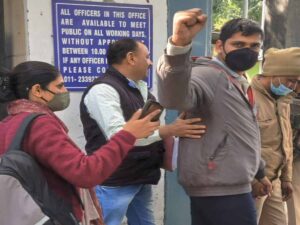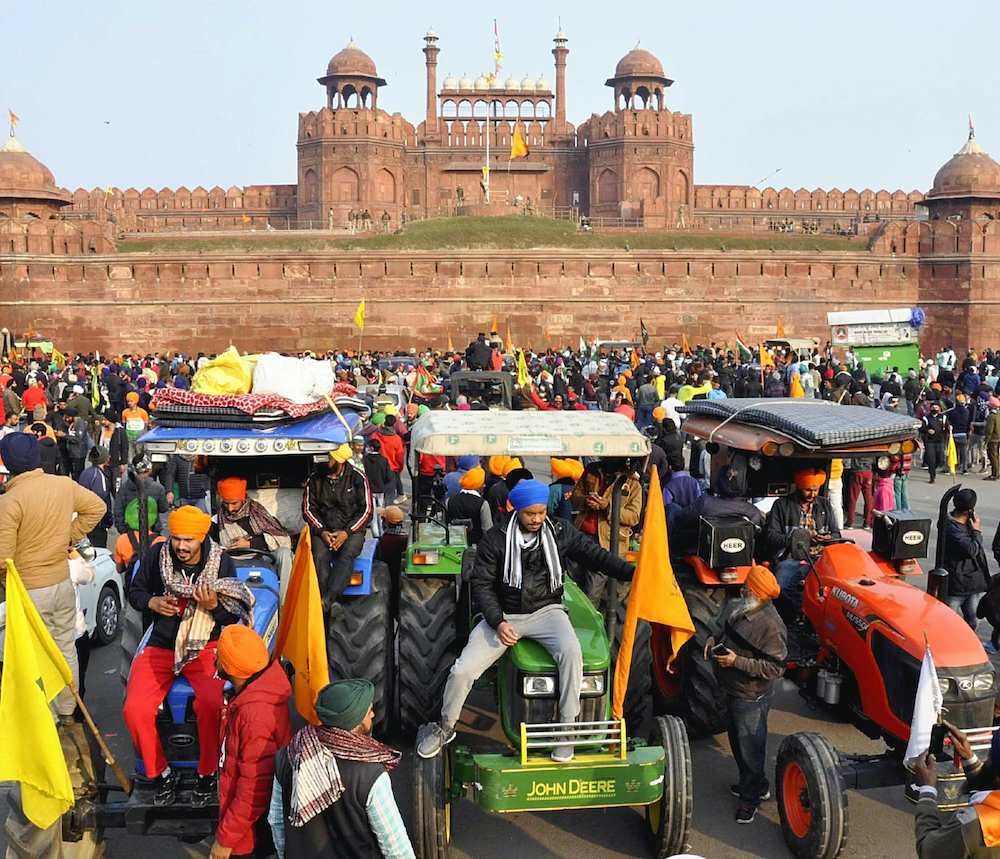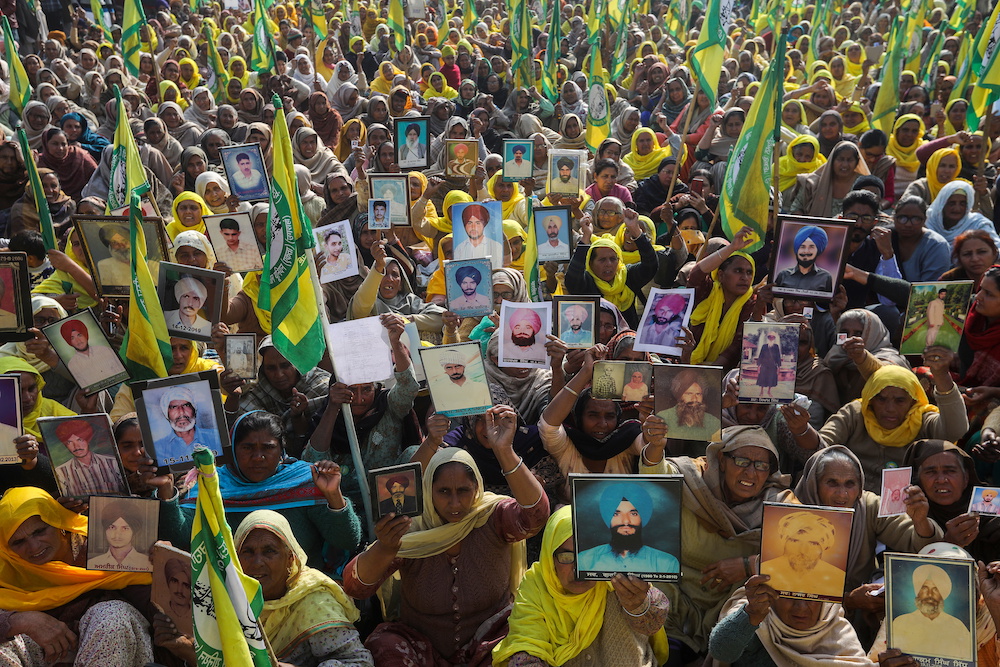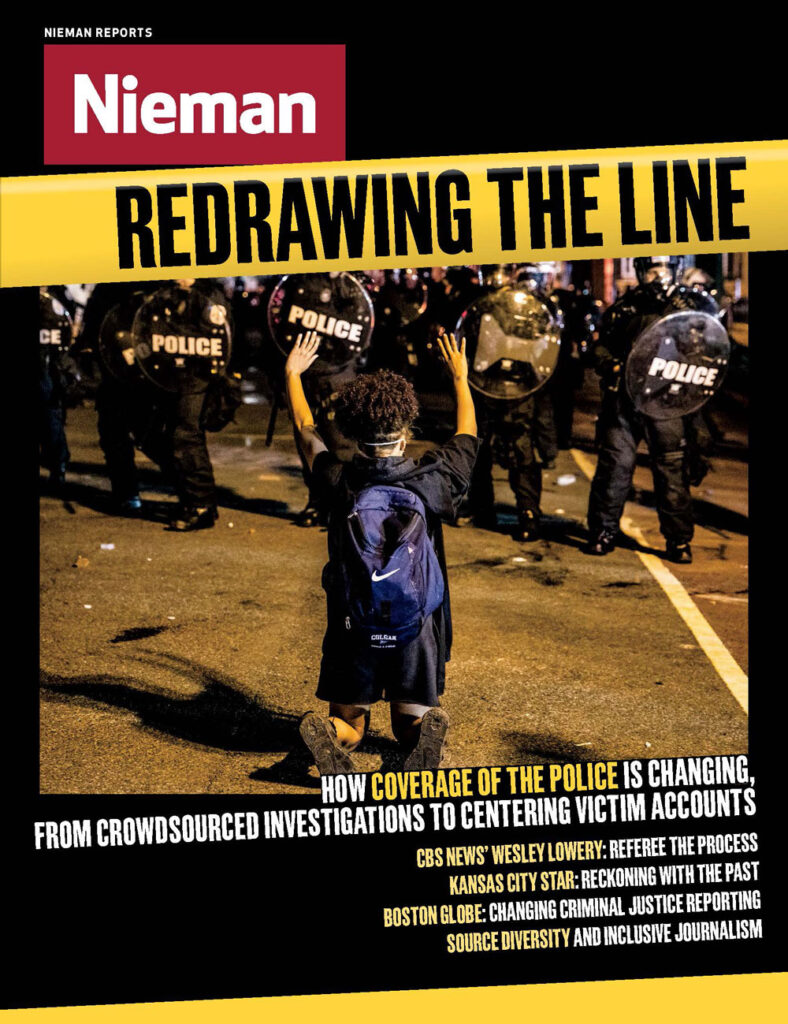The past few weeks have been challenging for independent media in India.
At least nine Indian journalists found themselves facing criminal charges for reporting that police allegedly shot a farmer during protests in Delhi at the end of January. The journalists reporting on the case were charged with sedition, even though the reporting was later found to be accurate. The police claimed that the man had died from an overturned tractor. Footage and an autopsy report showed he had gunshot wounds.
Twitter temporarily blocked the accounts of some 100 activists, journalists, and publications that have been critical of the government, including that of independent magazine The Caravan, which specializes in long-form investigative journalism. Twitter blocked the accounts at the request of the Ministry of Electronics and Information Technology, according to Indian media sources. The accounts were later restored.
One Caravan freelance journalist, Mandeep Punia — who was arrested and jailed for more than two days after posting a video of the farmer’s protests — interviewed farmers who had been jailed with him and, in the absence of a notebook, took notes on his legs so he could file a story after his release on bail.
These attacks on the free press come after years of growing repression from the Modi government. “The Modi government has created a climate of fear,” says Aliya Iftikhar, who researches Indian freedom-of-the-press issues for the Committee to Protect Journalists. For both Indian outlets and non-Indian outlets, the situation has become more dangerous, while new legislation makes it more difficult for remaining independent outlets to continue doing their work.
Modi’s government has intensively sued journalists on charges of sedition and treason. Even when prosecutors are unlikely to win cases, journalists accused of sedition or fighting an accusation under a terrorism law must spend time and money rebutting allegations. “The judicial process is very, very slow,” says Iftikhar — and expensive, a significant drain on independent outlets’ already tenuous finances.
Recent years have seen “criminal cases lodged against journalists in India for their work, with a majority of cases in BJP-ruled states,” according to a report by the Free Speech Collective, an Indian freedom-of-the-press organization. “They are going profession after profession,” says investigative journalist and Caravan contributor Vidya Krishnan of the legal onslaught. “It’s not just journalists [but] poets and intellectuals and comedians.”
These attacks on the free press come after years of growing repression from the Modi government
Violence against journalists has also grown. The Free Speech Collective calculates that in the last decade “154 journalists in India were arrested, detained, interrogated or served ‘show cause notices’ [which indicate that a party must appear before court] for their professional work.” More than 40% of those cases took place in 2020.
The situation is especially dire for journalists in rural areas, who lack the visibility and following of those based in large cities. Rural journalists “are not necessarily writing against Modi or the government or these laws or on farmer protests,” says one journalist working in India, who for safety reasons asked not to be identified. “They might write on corruption in a small town. They might write on sand smuggling [sand, used in construction, is an increasingly expensive resource in India] somewhere or coal smuggling or the coal mafia. [But because] all those things are being also controlled somehow by the government, the next day you will find somebody is being run over by a truck, somebody has been shot. And those stories really don't come out.”

One example is Siddique Kappan, a journalist based in Kerala who was arrested when reporting on a rape over four months ago. He is still in jail, though in mid-February was granted five days’ bail to visit his ailing mother.
Trolling from individuals and bots associated with Hindu nationalists has also become more common. Hindu Nationalism has grown under Modi, bringing with it more abuse and violence against minorities and journalists from trolls and followers inflamed by the BJP’s rhetoric. “Most of times they find your number, they start getting into your WhatsApp inbox, your Instagram, Facebook, Twitter; you get hate mail in huge numbers. And then there's always this thing in your mind, what if they find my address, and they just come here and start doing whatever they like to do?” this journalist explains. Trolls “have this impunity, where they can just do anything and then get away with it.”
Most investigative and critical reporting in India is done by independent outlets, many of which are online only. A recent ministerial orderis having further consequences for the country's journalists, even as the scope of the new law’s long-term consequences remain unclear.
The ministerial order, which goes into effect in November 2021, clarified that digital information platforms cannot receive more than 26% of their funding from sources outside India. Similar regulation already exists to regulate television and print media companies. This limits how much digital media can fundraise, restricting the size and scope of newsrooms. Legacy media in India are funded by government advertising contracts, so reporters often find themselves trying to investigate officials who are indirectly funding their stories. Outside funding from investors gave digital media a sense of independence and protection from politics.
In October, the Indian government sent an email to a number of online outlets informing them of the new policy. Many of the sites that received the email, which was seen by Nieman Reports, were known for their investigative reporting, such as The Wire as well as Kashmir Reader, a site based in that contested region. The email itself only referred to the revised legislation. Still, “it’s pretty clear from the [revised policy] that it is meant to control digital media,” says Manisha Pande, executive editor of Newslaundry, which publishes investigative and daily reporting on Indian politics. “For us to remain independent under these new rules ... in my mind it will make it tougher.”

Founded in 2012, Newslaundry has reported deeply on the Delhi riots last year, in which Hindu mobs attacked and killed Muslim residents, and published award-winning investigations into the lack of safety gear for health workers during the coronavirus pandemic. As the government attacks journalists for reporting on the farmer’s protests, Newslaundry has continued to interview farmers protesting against the agrarian laws. In a story published in early February, protestors describe how they look forward to voting out the BJP.
“Like many legislations in the last few years, there have been clarifications and clarifications,” says Abhinandan Sekhri, Newslaundry co-founder and CEO. “At the face of it, it impacts anyone who has taken investments and runs a digital information platform.” He notes that even funds within India but have outside investments may qualify as “foreign” sources of capital.
Most investigative and critical reporting in India is done by independent outlets, many of which are online only
“We often crowdfund our reporting, and we can do that because we’re small,” says Pande. “And because we’re small, we can take on the big guys.” But a cap on outside capital limits the eventual growth of the site. Newslaundry receives much of its revenue from subscriptions but has also raised money from the Omidyar Network, an international philanthropic network. “Individual organizations will now have to look at their future growth plans,” Sekhri adds.
The accusation of “foreign meddling” echoes that used by another authoritarian ruler, President Rodrigo Duterte of the Philippines, who has attacked media critical of his murderous war on drugs and other assaults on individual lives and liberties. Duterte has gone after Rappler, an independent news site in the Philippines that has been funded by outside networks like Omidyar. The site’s co-founder and CEO, Maria Ressa, has faced 10 criminal charges in the past two years. In June of last year, she was found guilty of “cyberlibel” for Rappler’s reporting about the links between a businessman and a now-deceased judge. The case has an uncertain legal basis; Rappler has stated that the charge of “cyberlibel” did not exist at the time of the article’s publication. In January, Ressa faced a new cyberlibel charge concerning a story about students allegedly paying a professor.
Digital media platforms have anticipated this legislation for several years. Last year, a group of digital news outlets, including Newslaundry, set up the DIGIPUB News India Foundation, a consortium that represents digital news media organizations and advocates on their behalf. The organization works for the independence of digital news media by encouraging different outlets to share resources. In the past few weeks, it has also been tracking the arrests of journalists and raids against newsrooms.
Details on how widely the legislation will apply are still unclear, but its effects are expected to be far-reaching, and some can already be seen. The legislation may be used in the future to curb the expansion of European and American media in India or may affect tech companies that display journalistic content, like Facebook.
HuffPost India has already closed. Indrani Basu, who worked as news and politics editor of HuffPost India from its launch in 2014 to 2018, was initially excited by the independence of digital media. “You couldn’t take away our advertisement or funding,” she says. Over the last six years, the site gained a strong reputation for accountability journalism covering the Delhi riots in February 2020, government corruption in the sand-mining business, and how the Indian government faked data to boost the idea of “Digital India.”
The future of this kind of investigative work is now in question, as is reporting done about the crisis in Kashmir, much of which was also published by HuffPost. This work, done by local correspondents who “were living that experience in Kashmir” and whose voices are rarely heard in legacy media, may now be harder to access, says Basu.
“In Kashmir, we were already witnessing intensified state intervention,” says Aakash Hassan, a journalist based in Kashmir who has written about how the Kashmiri “cyber police” torture social media users. A few months ago, one of his colleagues working on a similar story was called to a police station and beaten there. “They are trying to criminalize journalism ... It’s becoming extremely, extremely difficult to operate and work as a journalist. It’s nearly impossible.”
Meanwhile, the government has gone after other independent media — like The Caravan, known for its aggressive reporting — in new ways. In 2018 The Caravan published numerous articles critical of the BJP, such as an article about the BJP’s national president’s finances as well as investigations into the mysterious death of a judge who had been presiding over a murder trial involving a close friend of Modi’s. The Caravan “has become an orphanage for journalists who were edged out of legacy newsrooms like myself,” says contributor Krishnan.
In a conversation that took place at the end of December, before the farmers’ protests and most recent government crackdown, Caravan editor Vinod Jose said that four journalists from his newsroom had been attacked in the previous three months while reporting in a Delhi neighborhood where Muslims were killed in riots. “It’s a small newsroom but they are closely being watched by the intelligence agencies and the mobs,” Jose said of his colleagues.
Journalists in India continue to report, despite the obstacles
“We saw the change in the media landscape probably a year before [Modi] came to power” in 2014, Jose said. “We could see a number of editors changing, the coverage changing.” When Modi took power, “You could see a direct proactive involvement” from the government in newsrooms. Around that time, The Caravan started receiving stories from independent journalists that other publications no longer wanted to publish.
Since the farmers’ protests, Jose says, the magazine has faced a legislative onslaught: ten sedition cases against him personally in five states, as well as against the publishers of the magazine for coverage of the protests.
There has been "no resistance from publishers whatsoever,” Jose said of mainstream media in the country. If anything, he suggested, owners of legacy media companies, many of whom have remained close to Modi, may stand to gain by a decline in digital media. Last August, the editorial page of The Hindustan Times called the legislation limiting foreign funding a “welcome move,” and argued that the “government should also expand the definition of digital media” to include more outlets.
Meanwhile, journalists in India continue to report, despite the obstacles. Says Krishnan, the investigative journalist, “We are fighting for whether truth is meaningful or not.”
Correction: This article has been updated to remove an inaccurate description, introduced during the editorial process, of the use of a hashtag in coverage of the farmers’ protests.




